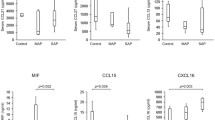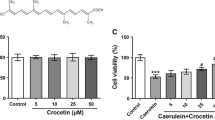Abstract
Based on the function of chemokine fractalkine (FKN), acting as both adhesion and chemoattractant, FKN plays a role in acute inflammatory response. In this study, we investigated the mechanism of FKN mediated upregulation inflammation in severe acute pancreatitis (SAP) rat models. Western blot, reverse transcriptase-polymerase chain reaction, and immunofluorescence demonstrated that FKN and its receptor CX3CR1 were overexpressed in cerulein-stimulated AR42J cells. AG490 and FKN-siRNA inhibited activation of Janus kinase/signal transducers and activators of transcription (Jak/Stat) in cerulein-stimulated AR42J cells. Following exposure AG490 and FKN-siRNA inhibited tumor necrosis factor-alpha expression by enzyme-linked immunosorbent assay and immunohistochemistry in vivo the SAP rat models. These results showed FKN and CX3CR1 were involved inflammatory response in cerulein-stimulated AR42J cells. FKN upregulates inflammation through CX3CR1 and the Jak/Stat pathway in SAP rat models.







Similar content being viewed by others
REFERENCES
Harrison, D.A., G. D’Amico, and M. Singer. 2007. The Pancreatitis Outcome Prediction (POP) Score: a new prognostic index for patients with severe acute pancreatitis. Critical Care Medicine 35: 1703–1708.
Bazan, J.F., K.B. Bacon, G. Hardiman, et al. 1997. A new class of membrane bound chemokine with a CX3C motif. Nature 385: 640–644.
Volin, M.V., J.M. Woods, M.A. Amin, M.A. Connors, L.A. Harlow, and A.E. Koch. 2001. Fractalkine: a novel angiogenic chemokine in rheumatoid arthritis. The American Journal of Pathology 159: 1521–1530.
Lee, S.J., S. Namkoong, Y.M. Kim, et al. 2006. Fractalkine stimulates angiogenesis by activating the Raf-1/MEK/ERK- and PI3K/Akt/eNos-dependent signal pathways. American Journal of Physiology-Heart and Circulatory Physiology 291: H2836–H2846.
Efsen, E., C. Grappone, R.M. DeFranco, et al. 2002. Up-regulated expression of fractalkine and its receptor CX3CR1 during liver injury in humans. Journal of Hepatology 37: 39–47.
Segerer, S., E. Hughes, K.L. Hudkins, M. Mack, T. Goodpaster, and C.E. Alpers. 2002. Expression of the fractalkine receptor (CX3CR1) in human kidney disease. Kidney International 62: 488–495.
Kishimoto, T., T. Taga, and S. Akira. 1994. Cytokine signal transduction. Cell 76: 253–262.
Igaz, P., S. Toth, and A. Falus. 2001. Biological and clinical significance of the JAK-STAT pathway; lessons from knockout mice. Inflammation Research 50: 435–441.
Rawlings, J.S., K.M. Rosler, and D.A. Harrison. 2004. The JAK/STAT signaling pathway. Journal of Cell Science 117: 1281–1283.
Levitzki, A., and A. Gazit. 1995. Tyrosine kinase inhibition: an approach to drug development. Science 267: 1782–1788.
Chen, P., Y. Yuan, S. Wang, L. Zhan, and J. Xu. 2006. Captopril, an angiotensin converting enzyme inhibitor, attenuates the severity of acute pancreatitis in rats by reducing expression of matrix metalloproteinase. The Tohoku Journal of Experimental Medicine 209: 99–101.
Yu, J.H., K.H. Kim, and H. Kim. 2006. Suppression of IL-1β expression by the Jak 2 inhibitor AG490 in cerulein-stimulated pancreatic acinar cells. Biochemical Pharmacology 72: 1555–1562.
Grewal, H.P., E.L. Mohey, A. Din, L. Gaber, M. Kotb, and A.O. Gaber. 1994. Amelioration of the physiologic and biochemical changes of acute pancreatitis using an anti-TNF-alpha polyclonal antibody. Am. J. Sug 167: 214–218.
Zhang, Xi-Ping, J. Zhang, Mei-Li Ma, et al. 2010. Pathological changes at early stage of multiple organ injury in a rat model of severe acute pancreatitis. Hepatobiliary & Pancreatic Diseases International 9: 83–85.
Zhang, Q., K. Shimoya, K. Temma, et al. 2004. Expression of fractalkine in the fallopian tube and of CX3CR1 in sperm. Human Reproduction 19: 409–414.
Ancuta, P., R. Rao, A. Moses, A. Mehle, et al. 2003. Fractalkine preferentially mediates arrest and migration of CD16 monocytes. Journal of Experimental Medicine 197: 1701–1707.
Fraticelli, P., M. Sironi, G. Bianchi, et al. 2001. Fractalkine (CX3CL1) as an amplification circuit of polarized Th1 responses. Journal of Clinical Investigation 107: 1173–1181.
Umehara, H., E.T. Bloom, T. Okazaki, Y. Nagano, O. Yoshie, and T. Imai. 2004. Fractalkine in vascular biology: from basic research to clinical disease. Arteriosclerosis, Thrombosis, and Vascular Biology 24: 34–40.
Haskell, C.A., M.D. Cleary, and I.F. Charo. 2000. Unique role of the chemokine domain of fractalkine in cell capture: kinetics of receptor dissociation correlate with cell adhesion. Journal of Biological Chemistry 275: 34183–34189.
Garton, K.J., P.J. Gough, C.P. Blobel, et al. 2001. Tumor necrosis factor-alpha-converting enzyme (ADAM17) mediates the cleavage and shedding of fractalkine (CX3CL1). Journal of Biological Chemistry 276: 37993–38001.
Combadiere, C., S. Potteaus, J.L. Gao, et al. 2003. Decreased atherosclerotic lesion formation in CX3CR1/apolipoprotein E double knockout mice. Circulation 107: 1009–1016.
Eriksson, E.E. 2004. Mechanisms of leukocyte recruitment to atherosclerosclerotic lesions: future prospects. Current Opinion in Lipidology 15: 5911–5918.
Duxbury, M.S., E. Matros, H. Ito, M.J. Zinner, S.W. Ashley, and E.E. Whanq. 2004. Systemic siRNA-mediated gene silencing: a new approach to targeted therapy of cancer. Annals of Surgery 240(4): 667–674.
Filleur, S., A. Courtin, S. Ali, et al. 2003. siRNA-mediated inhibition of vascular endothelial growth factor severely limits tumor resistance to antiangiogenic thrombospondin-1 and slows tumor vascularization and growth. Cancer Research 63(14): 3919–3922.
Sioud, M. 2010. Advances in RNA sensing by the immune system: separation of siRNA unwanted effects from RNA inference. Methods in Molecular Biology 629: 33–52.
Brummelkamp, T.R., R. Bernards, and R. Agami. 2002. Stable suppression of tumorigenicity by virus-mediated RNA interference. Cancer Cell 2(3): 243–247.
Chetty, C., P. Bhoopathi, P. Joseph, S. Chittivelu, Js Rao, and S. Lakka. 2006. Adenovirus -mediated siRNA against MMP-2 suppresses tumor growth and lung metastasis in mice. Molecular Cancer Therapeutics 5(9): 2289–2299.
Kisseleva, T., S. Bhattacharya, J. Braunstein, and C.W. Schindler. 2002. Signaling through the JAK/STAT pathway, recent advances and future challenges. Gene 285: 1–24.
Pelletier, S., F. Duhamel, P. Coulombe, M.R. Popoff, and S. Meloche. 2003. Rho family GTPase are required for activation of Jak/Stat signaling by G protein couple receptors. Molecular and Cellular Biology 23: 1316–1333.
Author information
Authors and Affiliations
Corresponding author
Rights and permissions
About this article
Cite this article
Huang, Ly., Chen, P., Xu, Lx. et al. Fractalkine Upregulates Inflammation through CX3CR1 and the Jak–Stat Pathway in Severe Acute Pancreatitis Rat Model. Inflammation 35, 1023–1030 (2012). https://doi.org/10.1007/s10753-011-9406-5
Published:
Issue Date:
DOI: https://doi.org/10.1007/s10753-011-9406-5




